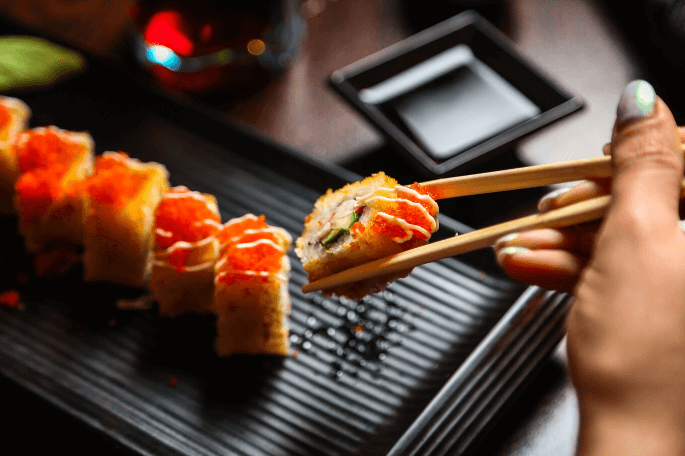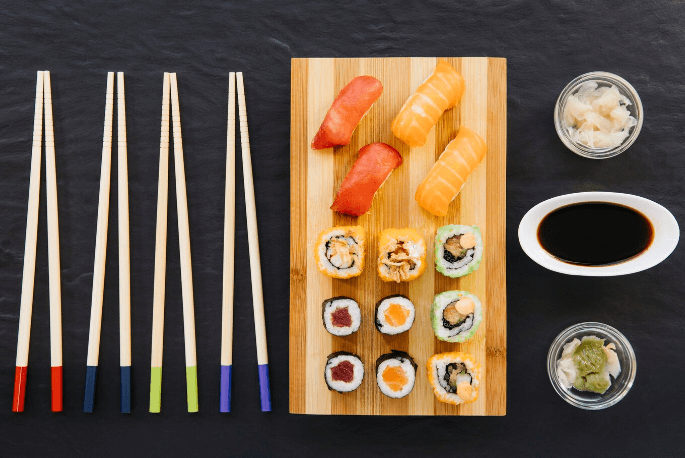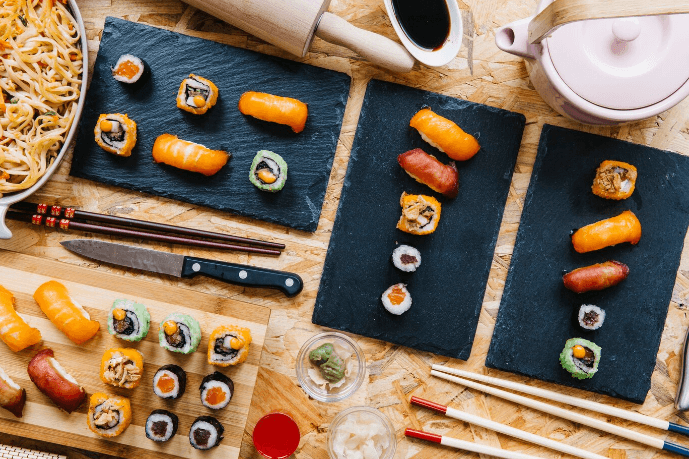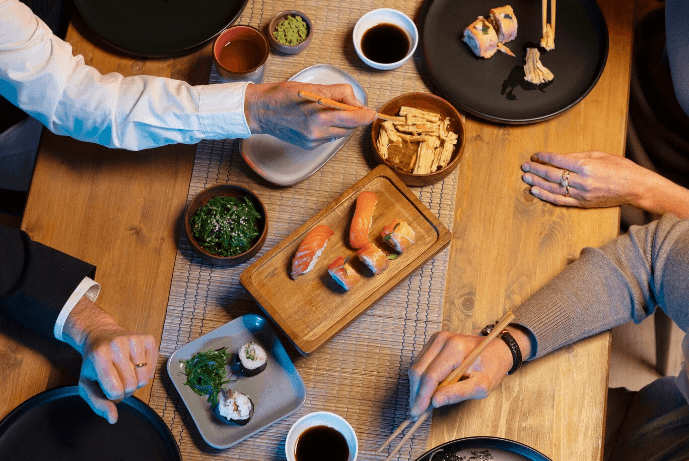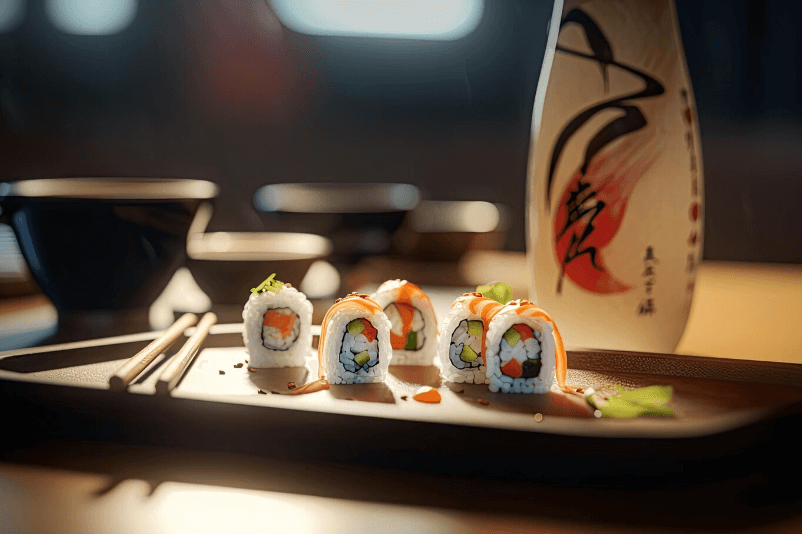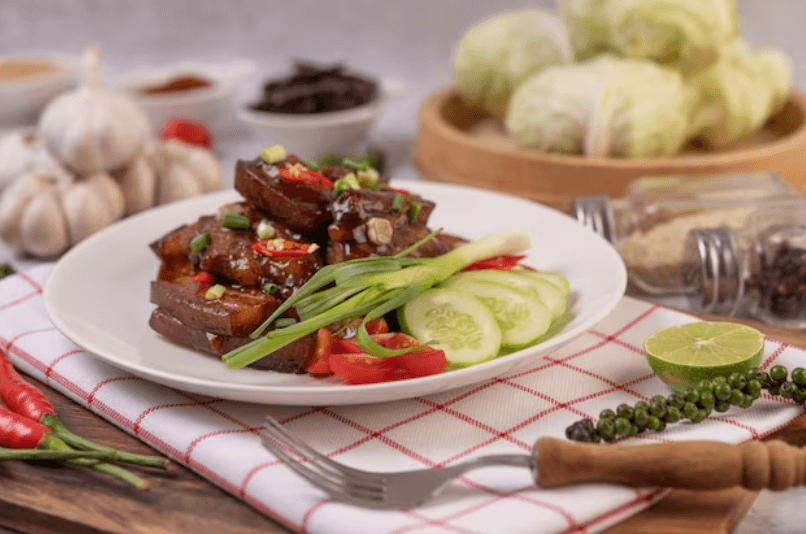How Many Calories in Sushi Rice?

Sushi is a beloved Japanese dish that has captured the hearts of foodies worldwide. It’s light, flavorful, and perfect for those who want to enjoy a healthy meal without compromising on taste. But have you ever wondered about the nutritional value of sushi rice? How many calories are in it? Is it really as healthy as we think it is? In this blog post, we’re going to dive into the world of sushi rice and explore its calorie content along with everything you need to know about incorporating it into your healthy diet. So grab some chopsticks and let’s get started!
What Is Sushi Rice?
Sushi rice is a type of short-grain white rice that is commonly used in Japanese cuisine to make sushi rolls, nigiri and other traditional dishes. It has a distinctive sticky texture due to its high starch content, which helps it hold together when rolled or shaped.
To prepare sushi rice, the grains are first washed and soaked before being cooked with water. Once cooked, the rice is seasoned with vinegar, sugar and salt to give it a sweet yet tangy flavor that complements the fish and other toppings used in sushi.
The quality of sushi rice can vary depending on factors such as where it was grown, how long it was aged for and how well it was prepared. The best sushi rice should be firm yet tender, lightly flavored with vinegar and have a slightly sweet taste.
While many people associate sushi with raw fish, there are also vegetarian options available that use ingredients like avocado or cucumber instead. Sushi can be enjoyed as part of a healthy diet when consumed in moderation as part of a balanced meal plan.
The Importance of Sushi Rice in Japanese Cuisine
Sushi rice, also known as shari, is an essential component of Japanese cuisine and plays a crucial role in sushi making. In fact, the quality of sushi rice can make or break the entire dish.
The importance of sushi rice lies in its ability to complement and balance the flavors of other ingredients while providing a soft texture that’s easy to eat with chopsticks. The sticky consistency allows the grains to hold together when shaped into rolls or pressed for nigiri.
Japanese chefs put great effort into selecting high-quality sushi rice that is plump, uniform in shape and free from unwanted debris. They also pay close attention to cooking times and seasoning with vinegar, sugar, salt and kombu seaweed for added flavor.
Beyond just being an ingredient in sushi dishes, Sushi rice serves as a staple food for many Japanese people. It’s typically consumed alongside various side dishes like pickled vegetables (tsukemono) or grilled fish (yakizakana).
Without properly cooked and seasoned sushi rice at hand – there would be no such thing as deliciously fresh sashimi-topped mounds of vinegared goodness!
Difference Between Sushi Rice and Regular Rice
Sushi rice and regular rice may look similar, but there are some key differences between the two. The type of rice used for sushi is short-grain Japanese rice, while regular rice can be long-grain or medium-grain from various regions around the world.
The texture of sushi rice is stickier than regular rice because it has a higher starch content. This allows it to hold its shape when rolled into sushi without falling apart. Sushi rice is also seasoned with vinegar and sugar, which gives it a slightly sweet and tangy flavor that complements the other ingredients in sushi rolls.
In contrast, regular white or brown rice is typically cooked plain without any seasoning. It has a more neutral taste and texture that makes it versatile for use in many different types of dishes.
Another difference is the way they are prepared. Sushi rice requires rinsing before cooking to remove excess starches on the surface, whereas this step isn’t always necessary for regular rice.
While both types of grains have their uses in various cuisines worldwide; chefs choose short-grained sticky Japanese variety specifically due to its unique properties that make it perfect for forming tight rolls with ease during preparation process of traditional Japanese delicacy like sushi!
Calorie Breakdown of Sushi Rice
When it comes to sushi, the rice is an essential component that gives it its unique texture and flavor. Sushi rice is different from regular rice due to the addition of vinegar seasoning, which gives it a tangy taste. However, many people are curious about how many calories are in sushi rice.
Raw sushi rice has around 350 calories per cup, making it a high-calorie food option. However, when cooked with water and vinegar seasoning, the calorie count reduces to approximately 200-250 calories per cup. This reduction occurs because some of the starches in raw sushi rice break down during cooking.
It’s worth noting that while plain white or brown rice might be healthier options than sushi rice regarding calorie content, they do not offer similar taste profiles or nutritional benefits as this Japanese staple.
Portion control plays a significant role in managing calorie intake while eating sushi. A typical serving size for one roll contains roughly one-third to half a cup of cooked sushi rice (50-75g), typically wrapped in seaweed with fish or vegetable fillings.
While consuming too much sushi could mean you’re taking on more calories than necessary; enjoying this dish moderately can fit into your healthy diet plan without compromising on nutrition and taste.
Raw Sushi Rice Calorie Count
Raw sushi rice is a staple ingredient for making traditional Japanese sushi. It refers to the uncooked white short-grain rice that has been washed and soaked in water before being cooked. Raw sushi rice contains around 360-370 calories per 100 grams, which makes it a high-calorie food.
One cup of raw sushi rice typically weighs about 200 grams and contains approximately 720-740 calories. This calorie count may vary based on the brand of rice used, as well as how it’s prepared.
While raw sushi rice may seem like an unhealthy option due to its high calorie content, it’s important to note that this ingredient is only one part of the overall nutritional profile of a piece of sushi. Other factors such as fish or vegetable fillings and portion size can greatly impact the healthiness of your meal.
If you’re looking to incorporate more low-calorie options into your diet, there are alternatives to using raw sushi rice when making homemade rolls. Options like cauliflower or quinoa “”rice”” can be used in place of traditional white rice for a lower calorie alternative.
Ultimately, while raw sushi rice does contain a significant amount of calories, with mindful portion control and balance within your overall diet, it can still be enjoyed as part of a healthy eating plan.
Cooked Sushi Rice Calorie Count
Cooked sushi rice is a staple ingredient in traditional Japanese cuisine. It is essential for making perfect sushi rolls, nigiri, and other popular dishes. Cooked sushi rice has a different calorie count than raw sushi rice because of the added water during cooking.
When cooked using the proper proportions of water and vinegar, one cup of cooked sushi rice contains approximately 240 calories. This amount may vary slightly depending on the brand or type of rice used for cooking.
It’s important to note that if you’re watching your calorie intake or trying to lose weight, portion control is key when it comes to eating cooked sushi rice. A typical serving size for cooked sushi rice is around 1/2 cup, which contains roughly 120 calories.
Some people might think that all types of rice are high in calories and should be avoided altogether; however, this isn’t necessarily true for every kind of plant-based food group. Sushi rice tends to have fewer calories than brown or white varieties since it’s usually mixed with vinegar before being served as part of a meal.
While cooked sushi rice does contain some number of calories per serving size; it remains an excellent source of healthy carbohydrates rich in fiber content alongside vitamins like iron and folate – vital nutrients our bodies need daily!
The Impact of Vinegar Seasoning
Vinegar seasoning is a crucial ingredient in sushi rice. It not only adds flavor but also helps to preserve the rice. The vinegar used for sushi is usually made from rice, which gives it a mellow and sweet taste that complements the other ingredients in sushi.
The vinegar seasoning plays an essential role in breaking down the starches in the rice during cooking, making it easier to digest. This process also makes the rice stickier and easier to mold into shapes when making different types of sushi rolls.
Depending on how much vinegar seasoning you add, it can impact the calorie count of your sushi rice. Typically, seasoned sushi rice contains around 40-60 calories per 100g serving.
It’s important to note that not all vinegars are created equal when it comes to their nutritional content. Some brands may contain added sugars or preservatives that can increase calorie counts or add unwanted chemicals to your food.
Using high-quality vinegar with minimal additives is best for creating healthy and flavorful sushi dishes at home.
Comparing Sushi Rice with Other Types of Rice
Sushi rice is a unique and integral component of Japanese cuisine. When compared to other types of rice, it has distinct differences in texture, taste, and nutritional value.
One popular type of rice that sushi rice is often compared to is white rice. White rice has a softer texture than sushi rice and lacks the vinegar seasoning used in sushi preparation. It also has fewer nutrients due to the removal of its outer layer during processing.
Brown rice is another comparison point for sushi rice. Brown rice retains its bran layer, which gives it a chewier texture than white or sushi rice. It is also more nutritious as it contains higher levels of fiber and minerals.
Black Rice or Forbidden Rice as some call it may be one grain you have never heard before but definitely deserves mention here as well with much less calorie than any type mentioned above plus high amounts of antioxidants!
While there are similarities between different types of rices, each variety offers unique benefits depending on individual dietary needs and preferences.
How Sushi Rice Fits into a Balanced Diet
Sushi rice is a staple ingredient in Japanese cuisine and has become increasingly popular worldwide. When it comes to maintaining a balanced diet, choosing the right type of carbohydrates can make all the difference. Sushi rice fits perfectly into a healthy eating plan due to its moderate calorie count and high nutritional value.
As with any food, portion control is key. A serving size of sushi rice should be about half a cup or 100 grams, which contains approximately 130 calories. This amount provides enough energy without overdoing it on carbs.
Additionally, sushi rice is rich in vitamins and minerals such as thiamin, niacin, magnesium, phosphorus, and potassium. It also contains small amounts of protein and fiber that promote satiety.
When combined with other ingredients like raw fish or vegetables in sushi rolls or bowls, sushi rice makes for an incredibly satisfying meal that won’t leave you feeling sluggish afterward.
Incorporating sushi rice into your diet can add variety while still providing essential nutrients needed for optimal health. As long as portions are controlled and balance is maintained throughout your meals, there’s no reason why you shouldn’t enjoy this delicious grain as part of your healthy eating routine!
Nutritional Profile of Sushi Rice
Sushi rice is a staple food in Japanese cuisine and has gained popularity worldwide. It is not only delicious but also offers various nutritional benefits that make it an excellent addition to your diet.
One cup of cooked sushi rice contains around 200 calories, which makes it a moderate source for energy. It also provides carbohydrates, fiber, and a small amount of protein. Sushi rice is low in fat, making it an ideal choice for those watching their weight.
Moreover, sushi rice contains essential vitamins and minerals such as thiamine (vitamin B1), niacin (vitamin B3), phosphorus, and magnesium. These nutrients help maintain healthy brain function and support the growth of strong bones.
The vinegar seasoning used in sushi rice helps balance blood sugar levels due to its acetic acid content. This can prevent sudden spikes or drops in blood sugar levels that lead to cravings for unhealthy snacks.
Incorporating sushi rice into your diet can benefit your overall health by providing energy, essential nutrients while being low in fat content. However, portion control plays a vital role when consuming any food item; enjoy this delicious treat mindfully!
Portion Control with Sushi Rice
When it comes to sushi, portion control is key. Sushi rice may be low in fat and cholesterol-free, but it still contains a significant amount of carbohydrates. Eating too much sushi rice can lead to weight gain if you don’t balance it out with other healthy foods.
One way to practice portion control is by ordering nigiri instead of rolls. Nigiri consists of a small ball of sushi rice topped with a piece of fish or other protein. It’s an excellent option for those watching their carb intake since there’s less rice per serving.
Another tip is to opt for sashimi instead of rolls or nigiri. Sashimi is simply raw fish without any rice or added ingredients. This makes it the perfect choice for those who want all the health benefits that come from eating seafood without adding extra carbs from the sushi rice.
If you do choose to eat rolls, consider sharing them with friends or taking half home for later. This will help prevent overeating and keep your portions under control.
Remember that sushi isn’t just about the rice – there are plenty of delicious options like seaweed salad, miso soup, edamame and cucumber salad that can make up a balanced meal alongside your favorite type of sushi.
Alternatives to Sushi Rice
If you’re looking for an alternative to traditional sushi rice, there are plenty of options available. One popular choice is brown rice, which offers a nuttier flavor and more nutrients than white rice. Another option is quinoa, which is high in protein and can add a unique texture to your sushi rolls.
For those who prefer low-carb alternatives, cauliflower rice or zucchini noodles can be used as a base instead of traditional sushi rice. These options offer fewer calories and carbohydrates while still providing the same delicious taste.
If you’re feeling adventurous, try using black or red rice in your next roll. These varieties have a distinct flavor profile that pairs well with seafood and other sushi ingredients.
If you want to avoid grains altogether, consider using seaweed wraps instead of traditional nori sheets. This option provides added nutrients like iodine and iron while giving your sushi rolls a unique twist.
No matter what alternative you choose, experimenting with different bases can allow you to create new flavors and textures in your homemade sushi rolls.
How to Make Low-Calorie Sushi at Home
Sushi is a popular Japanese dish that has gained worldwide recognition. While sushi can be healthy, it can also be high in calories due to the rice and other ingredients used. Making low-calorie sushi at home is an excellent way to enjoy this delicious dish without worrying about the calorie count.
To start making low-calorie sushi, opt for brown or black rice instead of traditional white sushi rice. These types of rice have more fiber and are lower in calories than white rice.
When choosing fillings for your rolls, go for lean protein options like cooked shrimp, crabmeat, or tuna instead of fried tempura fillings. You can also add vegetables like cucumber, avocado, carrots or bell peppers to increase the nutrient density while keeping the calorie count down.
Avoid adding too much mayonnaise-based sauces when making your own rolls as they tend to be high in calories. Instead use light soy sauce which has fewer calories and less sodium content
Portion control is essential when it comes to eating low-calorie sushi; try having one roll with a side salad rather than multiple servings of different varieties
Making low-calorie sushi at home doesn’t have to sacrifice taste or flavor! With some simple ingredient swaps and mindful portion control techniques you can still indulge in this savory treat while maintaining a healthy lifestyle.
Myths and Misconceptions About Sushi Rice
Sushi rice has been the subject of many myths and misconceptions over the years. One common misconception is that sushi rice is unhealthy due to its high calorie content. However, this couldn’t be further from the truth. While sushi rice contains more calories than regular white or brown rice, it’s an essential component of a balanced diet when consumed in moderation.
Another myth about sushi rice is that it should only be eaten with raw fish. Many people believe that sushi must always include raw seafood, but this simply isn’t true. Sushi can be made with a variety of ingredients, including cooked vegetables, egg, and even tofu.
Some people also assume that all types of sushi are high in sodium because they contain soy sauce. While soy sauce does contain salt, not all types of sushi are made using soy sauce as a seasoning agent.
Some people think that making good quality sushi requires specialized skills and equipment. While there certainly are techniques involved in making excellent sushi at home or in restaurants, with practice anyone can become skilled at preparing delicious homemade rolls using readily available tools like bamboo mats for rolling.
By dispelling these myths about sushi rice we can better appreciate its role as part of a healthy Japanese cuisine-based diet plan!
Exploring Other Healthy Japanese Foods
Japan has a rich culinary tradition that goes beyond sushi and rice. Japanese cuisine is known for its emphasis on fresh ingredients, balanced flavors, and minimal cooking techniques. This makes it an ideal choice for people who are looking to eat healthy without sacrificing flavor.
One of the most popular Japanese foods outside of sushi is miso soup. Made from fermented soybeans, miso soup is high in protein and low in calories. It also contains beneficial probiotics that promote gut health.
Another traditional Japanese dish that’s gaining popularity worldwide is soba noodles. Made from buckwheat flour, these thin noodles have a nutty flavor and are packed with fiber and minerals like magnesium and iron.
For those who love seafood but want to avoid raw fish, grilled or baked fish dishes like teriyaki salmon or mackerel can be a great option. Fish is an excellent source of omega-3 fatty acids which help reduce inflammation and support heart health.
Vegetable-based dishes like tempura vegetables or stir-fried greens are staples in Japanese cuisine. Vegetables such as shiitake mushrooms or daikon radish contain antioxidants that help protect against chronic diseases like cancer and diabetes.
Exploring other healthy Japanese foods beyond sushi rice opens up endless possibilities for nutritious meals full of flavor!
Eating Sushi Mindfully
Eating sushi mindfully is not just about enjoying the taste and texture of each bite, it’s also a way to stay in tune with your body’s hunger signals. Start by taking a moment to appreciate the presentation of your sushi roll or sashimi plate. Notice its colors, textures, and aromas before you take your first bite.
As you begin eating, focus on each piece individually. Take small bites and chew slowly to fully enjoy the flavor profile of each ingredient. Pay attention to how full you feel after each piece and stop when you are satisfied rather than stuffed.
Mindful eating can also help prevent overeating during a meal. By slowing down and savoring every aspect of your food, you may find that smaller portions satisfy you more than larger ones eaten quickly.
Remember that mindful eating isn’t just about what you eat but also how you eat it. Eating sushi with chopsticks or using your hands can add an extra level of mindfulness as these techniques require concentration and precision.
Conclusion
Sushi rice is a staple ingredient in Japanese cuisine that has gained popularity worldwide due to its unique flavor and versatility. While it is relatively high in calories compared to other types of rice, it can still be enjoyed as part of a healthy diet when consumed in moderation.
Portion control is key when it comes to eating sushi rice, and there are also alternatives such as cauliflower rice or quinoa that can be used for those looking for lower calorie options. Additionally, making your own low-calorie sushi at home using fresh ingredients allows you to customize the dish according to your preferences.
It’s important not to fall into common myths about sushi rice being unhealthy or fattening – with mindful eating habits and awareness of portion sizes, this delicious food can certainly fit into a balanced diet. By exploring other healthy Japanese foods and incorporating them into your meals along with sushi rice, you can enjoy the benefits of this nutritious cuisine while satisfying your taste buds.
